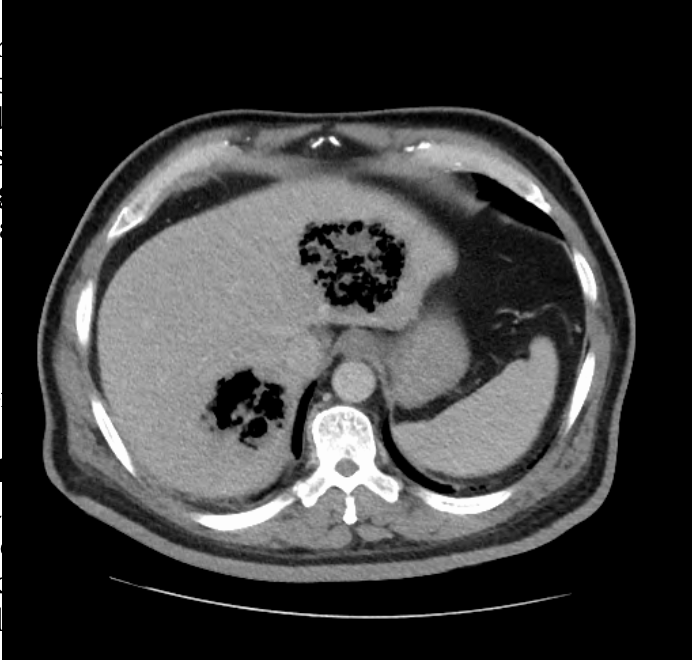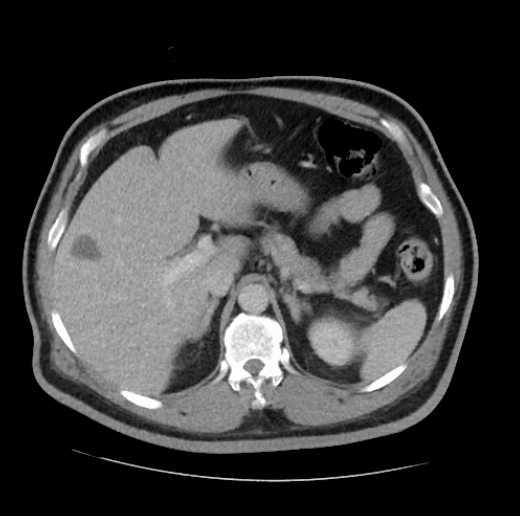Tuesday Poster Session
Category: Liver
P6142 - Severe Emphysematous Hepatitis in Uncontrolled Diabetes: A Case Report on Early Intervention and Outcomes
Tuesday, October 28, 2025
10:30 AM - 4:00 PM PDT
Location: Exhibit Hall
- TA
Tasneem Anagreh, MD
Ascension Saint Francis Hospital
Evanston, IL
Presenting Author(s)
Tasneem Anagreh, MD, Laith Sorour, MD, Bhargav Koyani, MD, Mariam Nikolaishvili, MD, Mohammed E. Faris, MD, Hieu Truong, MD, Ben Varghese, MD
Ascension Saint Francis Hospital, Evanston, IL
Introduction: Emphysematous hepatitis is a rare, life-threatening liver infection characterized by gas formation within hepatic parenchyma. It is frequently associated with diabetes mellitus and gastrointestinal malignancies. Common causative organisms include Klebsiella pneumoniae, Escherichia coli, and Clostridium species. The condition carries high mortality, especially within the first three days of admission, underscoring the need for early diagnosis and intervention. Research is limited, highlighting gaps in our understanding of its pathophysiology and optimal management.
Case Description/
Methods: We report a case of a 59-year-old man with poorly controlled type 2 diabetes who presented with one week of right upper quadrant pain, fever, chills, and night sweats, without vomiting or diarrhea. Examination revealed confusion, jaundice, and right upper quadrant tenderness with guarding. Labs showed elevated transaminases, conjugated hyperbilirubinemia, leukocytosis, and severe thrombocytopenia. Hemoglobin A1c was 10%, indicating chronic hyperglycemia.
CT abdomen revealed extensive gas collections in the liver, consistent with emphysematous hepatitis, and a focal hypodense area suggesting localized infection. Broad-spectrum antibiotics were initiated targeting Klebsiella, Clostridium, and Pseudomonas. Interventional radiology-guided aspiration yielded air and scant bloody fluid. Blood and aspirate cultures grew pan-sensitive Klebsiella pneumoniae. Glycemic control was achieved with insulin infusion.
Despite initial therapy, the patient’s condition worsened, requiring placement of three intrahepatic drains for source control. This led to clinical improvement, normalization of liver enzymes and platelets, and narrowing of antibiotics based on sensitivities. He is scheduled for colon cancer screening and will receive prolonged antibiotic therapy and intensified glucose management.
Discussion: This case underscores the diagnostic and therapeutic challenges posed by emphysematous hepatitis. Despite limited evidence, our experience—among few reported cases with survival—supports early drainage, even in the absence of purulent material. Early identification and aggressive, multidisciplinary management are vital for improving outcomes. Further research is needed to clarify risk factors, pathogenesis, and optimal treatment strategies for this rapidly fatal condition.

Figure: Large gas-forming hepatic collections consistent with emphysematous hepatitis.

Figure: Focal area of decreased density in the mid-right hepatic lobe suggestive of additional infection.
Disclosures:
Tasneem Anagreh indicated no relevant financial relationships.
Laith Sorour indicated no relevant financial relationships.
Bhargav Koyani indicated no relevant financial relationships.
Mariam Nikolaishvili indicated no relevant financial relationships.
Mohammed Faris indicated no relevant financial relationships.
Hieu Truong indicated no relevant financial relationships.
Ben Varghese indicated no relevant financial relationships.
Tasneem Anagreh, MD, Laith Sorour, MD, Bhargav Koyani, MD, Mariam Nikolaishvili, MD, Mohammed E. Faris, MD, Hieu Truong, MD, Ben Varghese, MD. P6142 - Severe Emphysematous Hepatitis in Uncontrolled Diabetes: A Case Report on Early Intervention and Outcomes, ACG 2025 Annual Scientific Meeting Abstracts. Phoenix, AZ: American College of Gastroenterology.
Ascension Saint Francis Hospital, Evanston, IL
Introduction: Emphysematous hepatitis is a rare, life-threatening liver infection characterized by gas formation within hepatic parenchyma. It is frequently associated with diabetes mellitus and gastrointestinal malignancies. Common causative organisms include Klebsiella pneumoniae, Escherichia coli, and Clostridium species. The condition carries high mortality, especially within the first three days of admission, underscoring the need for early diagnosis and intervention. Research is limited, highlighting gaps in our understanding of its pathophysiology and optimal management.
Case Description/
Methods: We report a case of a 59-year-old man with poorly controlled type 2 diabetes who presented with one week of right upper quadrant pain, fever, chills, and night sweats, without vomiting or diarrhea. Examination revealed confusion, jaundice, and right upper quadrant tenderness with guarding. Labs showed elevated transaminases, conjugated hyperbilirubinemia, leukocytosis, and severe thrombocytopenia. Hemoglobin A1c was 10%, indicating chronic hyperglycemia.
CT abdomen revealed extensive gas collections in the liver, consistent with emphysematous hepatitis, and a focal hypodense area suggesting localized infection. Broad-spectrum antibiotics were initiated targeting Klebsiella, Clostridium, and Pseudomonas. Interventional radiology-guided aspiration yielded air and scant bloody fluid. Blood and aspirate cultures grew pan-sensitive Klebsiella pneumoniae. Glycemic control was achieved with insulin infusion.
Despite initial therapy, the patient’s condition worsened, requiring placement of three intrahepatic drains for source control. This led to clinical improvement, normalization of liver enzymes and platelets, and narrowing of antibiotics based on sensitivities. He is scheduled for colon cancer screening and will receive prolonged antibiotic therapy and intensified glucose management.
Discussion: This case underscores the diagnostic and therapeutic challenges posed by emphysematous hepatitis. Despite limited evidence, our experience—among few reported cases with survival—supports early drainage, even in the absence of purulent material. Early identification and aggressive, multidisciplinary management are vital for improving outcomes. Further research is needed to clarify risk factors, pathogenesis, and optimal treatment strategies for this rapidly fatal condition.

Figure: Large gas-forming hepatic collections consistent with emphysematous hepatitis.

Figure: Focal area of decreased density in the mid-right hepatic lobe suggestive of additional infection.
Disclosures:
Tasneem Anagreh indicated no relevant financial relationships.
Laith Sorour indicated no relevant financial relationships.
Bhargav Koyani indicated no relevant financial relationships.
Mariam Nikolaishvili indicated no relevant financial relationships.
Mohammed Faris indicated no relevant financial relationships.
Hieu Truong indicated no relevant financial relationships.
Ben Varghese indicated no relevant financial relationships.
Tasneem Anagreh, MD, Laith Sorour, MD, Bhargav Koyani, MD, Mariam Nikolaishvili, MD, Mohammed E. Faris, MD, Hieu Truong, MD, Ben Varghese, MD. P6142 - Severe Emphysematous Hepatitis in Uncontrolled Diabetes: A Case Report on Early Intervention and Outcomes, ACG 2025 Annual Scientific Meeting Abstracts. Phoenix, AZ: American College of Gastroenterology.
